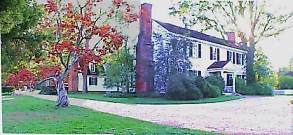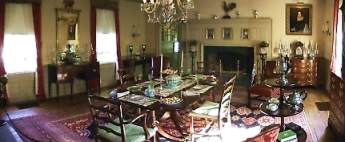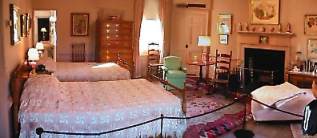Bassett Hall
Williamsburg, VA
October 30, 1999
 When visiting Williamsburg be sure to include
Bassett Hall on your tour. It is included in most of the entry
passes. Although from the outside Bassett Hall appears to be just
a simple two-story 18th-century white frame farmhouse, its
importance is that it was once the Williamsburg home of John D.
Rockefeller, Jr., one of America's richest men.
When visiting Williamsburg be sure to include
Bassett Hall on your tour. It is included in most of the entry
passes. Although from the outside Bassett Hall appears to be just
a simple two-story 18th-century white frame farmhouse, its
importance is that it was once the Williamsburg home of John D.
Rockefeller, Jr., one of America's richest men.
The house is believed to have been built between 1753 and 1766 by
Philip Johnson, a member of the House of Burgesses from King and
Queen County. Burwell Bassett, a state legislator, congressman,
and Martha Washington's nephew, bought the place in 1800.
During the Civil War, Union cavalryman George Armstrong Custer
spent 10 days after the Battle  of Williamsburg as a guest in the Rebel
household. He had taken leave to attend the wedding of his West
Point classmate John W. Lea. Lea, a Carolina Confederate, was
wounded during the battle. While he recuperated at Bassett Hall,
Lea became engaged to one of the daughters in the family.
of Williamsburg as a guest in the Rebel
household. He had taken leave to attend the wedding of his West
Point classmate John W. Lea. Lea, a Carolina Confederate, was
wounded during the battle. While he recuperated at Bassett Hall,
Lea became engaged to one of the daughters in the family.
In order to understand the history behind Rockefeller and
Williamsburg we first have to look at Dr. W.A.R. Goodwin who was
the rector of Bruton Church. If not for this man and his vision
Williamsburg might have gone the way of other historic
buildings; torn down to make room for "progress". By
the 1920's Williamsburg had become a small mud-choked southern
village. The historic buildings that still remained had been
changed to boarding houses and gas stations, with cheap board
fronts put up on them. Dr. Goodwin, who had become the pastor of
the Bruton Church, driven by his vision, was able to get two
buildings restored in Williamsburg, but he lacked the funds to
restore Williamsburg on the scale that he wanted to. He went to
several millionaires but failed to get their attention. He
realized that he had to find a different aspect that would
interest a man with money to
have gone the way of other historic
buildings; torn down to make room for "progress". By
the 1920's Williamsburg had become a small mud-choked southern
village. The historic buildings that still remained had been
changed to boarding houses and gas stations, with cheap board
fronts put up on them. Dr. Goodwin, who had become the pastor of
the Bruton Church, driven by his vision, was able to get two
buildings restored in Williamsburg, but he lacked the funds to
restore Williamsburg on the scale that he wanted to. He went to
several millionaires but failed to get their attention. He
realized that he had to find a different aspect that would
interest a man with money to  fund the restoration. In 1926, John D.
Rockefeller, Jr., came to William and Mary College for the
dedication of a building honoring the Phi Beta Cappa Society, to
which both he and Dr. Goodwin belonged. The Reverend Dr. W. A. R.
Goodwin took this opportunity to interest John D. Rockefeller,
Jr., in Williamsburg's restoration. He presented to him the idea
of restoring an "entire village" not just one building.
Bassett Hall was among the first places he showed the visiting
philanthropist and oil-fortune heir. Of particular interest was
the Great Oak, a huge old tree that was already in its 80s when
the Stamp Act Crisis rocked the colonies. Rockefeller said,
"It is a place to sit in silence and let the past speak to
us." Unfortunately the great oak finally succumbed to a
severe ice storm in the winter of 1998.
fund the restoration. In 1926, John D.
Rockefeller, Jr., came to William and Mary College for the
dedication of a building honoring the Phi Beta Cappa Society, to
which both he and Dr. Goodwin belonged. The Reverend Dr. W. A. R.
Goodwin took this opportunity to interest John D. Rockefeller,
Jr., in Williamsburg's restoration. He presented to him the idea
of restoring an "entire village" not just one building.
Bassett Hall was among the first places he showed the visiting
philanthropist and oil-fortune heir. Of particular interest was
the Great Oak, a huge old tree that was already in its 80s when
the Stamp Act Crisis rocked the colonies. Rockefeller said,
"It is a place to sit in silence and let the past speak to
us." Unfortunately the great oak finally succumbed to a
severe ice storm in the winter of 1998.
Goodwin  encouraged Rockefeller to buy the house, and
it became the Rockefellers' residence during their twice-annual
trips to the city. It also became the Rockefellers' retreat from
the world. Mrs. Abby Aldrich Rockefeller decorated it with folk
art.
encouraged Rockefeller to buy the house, and
it became the Rockefellers' residence during their twice-annual
trips to the city. It also became the Rockefellers' retreat from
the world. Mrs. Abby Aldrich Rockefeller decorated it with folk
art.
A Rockefeller biographer wrote, "Perhaps his favorite
residence--the one that most attracted him in his later
years--was the small white house known as Bassett Hall in
Williamsburg. Here, surrounded by the details of a vast project,
he found the satisfaction of creation, of being a part of one of
his own great dreams."
The house remained in the Rockefeller family until 1979, when it
was bequeathed to Colonial Williamsburg. It is shown to the
public (reservations are required) as it looked in the 1930s,
with many of the Rockefellers' furnishings and 125 of Mrs.
Rockefeller's folk art pictures, chalkware figurines, pottery,
needlework, and weather vanes. In going through the house today
you can see the love that the Rockefellers felt for this home.
*** THE END ***
Good Luck! Have Fun! and Stay Safe!
Laura